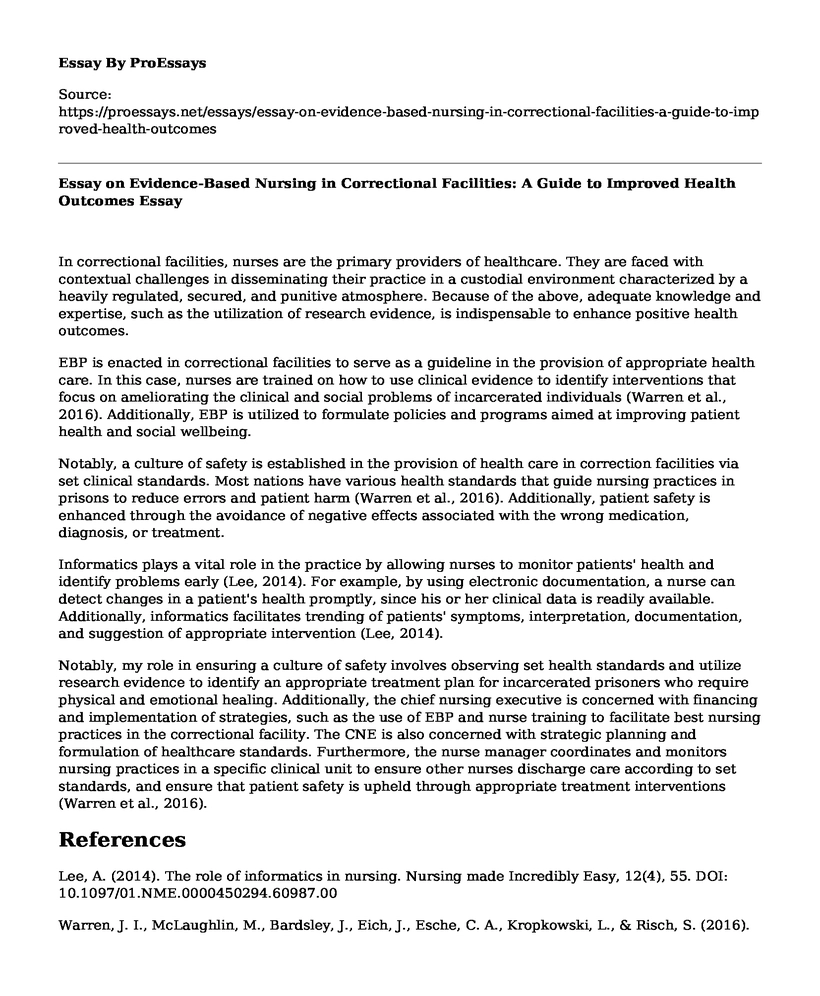In correctional facilities, nurses are the primary providers of healthcare. They are faced with contextual challenges in disseminating their practice in a custodial environment characterized by a heavily regulated, secured, and punitive atmosphere. Because of the above, adequate knowledge and expertise, such as the utilization of research evidence, is indispensable to enhance positive health outcomes.
EBP is enacted in correctional facilities to serve as a guideline in the provision of appropriate health care. In this case, nurses are trained on how to use clinical evidence to identify interventions that focus on ameliorating the clinical and social problems of incarcerated individuals (Warren et al., 2016). Additionally, EBP is utilized to formulate policies and programs aimed at improving patient health and social wellbeing.
Notably, a culture of safety is established in the provision of health care in correction facilities via set clinical standards. Most nations have various health standards that guide nursing practices in prisons to reduce errors and patient harm (Warren et al., 2016). Additionally, patient safety is enhanced through the avoidance of negative effects associated with the wrong medication, diagnosis, or treatment.
Informatics plays a vital role in the practice by allowing nurses to monitor patients' health and identify problems early (Lee, 2014). For example, by using electronic documentation, a nurse can detect changes in a patient's health promptly, since his or her clinical data is readily available. Additionally, informatics facilitates trending of patients' symptoms, interpretation, documentation, and suggestion of appropriate intervention (Lee, 2014).
Notably, my role in ensuring a culture of safety involves observing set health standards and utilize research evidence to identify an appropriate treatment plan for incarcerated prisoners who require physical and emotional healing. Additionally, the chief nursing executive is concerned with financing and implementation of strategies, such as the use of EBP and nurse training to facilitate best nursing practices in the correctional facility. The CNE is also concerned with strategic planning and formulation of healthcare standards. Furthermore, the nurse manager coordinates and monitors nursing practices in a specific clinical unit to ensure other nurses discharge care according to set standards, and ensure that patient safety is upheld through appropriate treatment interventions (Warren et al., 2016).
References
Lee, A. (2014). The role of informatics in nursing. Nursing made Incredibly Easy, 12(4), 55. DOI: 10.1097/01.NME.0000450294.60987.00
Warren, J. I., McLaughlin, M., Bardsley, J., Eich, J., Esche, C. A., Kropkowski, L., & Risch, S. (2016). The strengths and challenges of implementing EBP in healthcare systems. Worldviews on EvidenceBased Nursing, 13(1), 15-24. https://doi.org/10.1111/wvn.12149
Cite this page
Essay on Evidence-Based Nursing in Correctional Facilities: A Guide to Improved Health Outcomes. (2023, Jan 29). Retrieved from https://proessays.net/essays/essay-on-evidence-based-nursing-in-correctional-facilities-a-guide-to-improved-health-outcomes
If you are the original author of this essay and no longer wish to have it published on the ProEssays website, please click below to request its removal:
- Communication in Public Health. Essay Example.
- The Nature and Background of the Emergency Response - Article Analysis Essay
- Lapse of Ethics in Healthcare Paper Example
- Essay Sample on Why Diabetes is a Threat: Insulin, Glucose, & Pancreas
- Colgate: From Local to Global in 21st Century - Essay Sample
- Essay Example on Reckless Driving, Moral Hazard, and Adverse Selection
- Essay Example on COVID-19: A Global Health Crisis with Over 1M Cases







